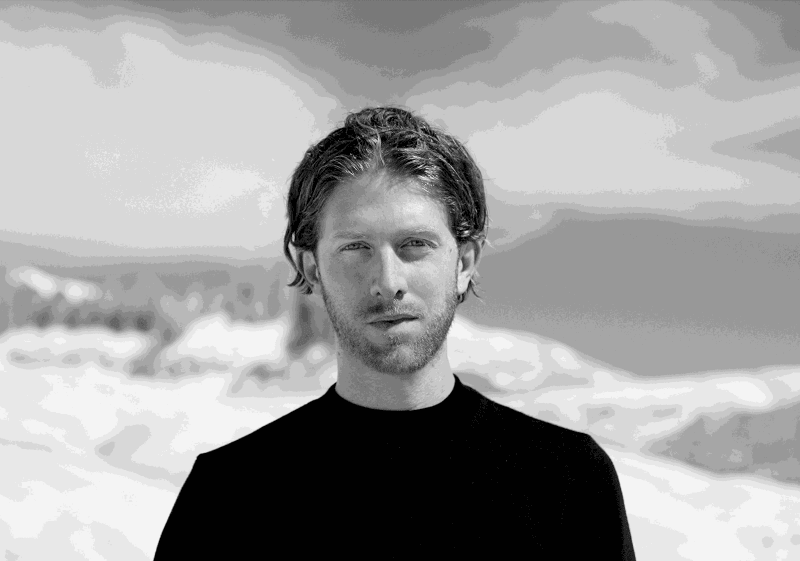The work of visual artist Douglas Mandry includes photography, print making, painting and sculpture. He works across different media, and the foundation of his art lies in a deep engagement with scientific topics and thorough research. Often, he closely collaborates with researchers and institutions from fields such as archaeology, technology, history, and the natural sciences. His work is a reflection on our relationship with nature, and addresses larger questions about the passage of time, memory, and transience versus preservation. His work plays with the dialectic between the possibility and impossibility of capturing time, natural evolution and societal change.
By letting his images interfere with natural elements like ice or dust and embracing processes such as erosion and decay, Mandry shows that matter matters. For instance, he prints his works on different materials, such as geotextiles used to protect glaciers for his series “Monuments” or on quasi-transparent silk in his latest project “Les Archives de la Planète”.
For Mandry, the artist is almost a co-creator rather than the sole author of his works, allowing the materials he works with - stones, ice, glass, ink, watercolours, and textiles - to take centre stage and interact with each other in such a way that processes can unfold in which the artist relinquishes absolute control over the end result, intentionally allowing for the interplay of these elements and for a certain degree of randomness to the visual outcome.
“Mandry loves the beauty of the unfinished. He doesn't create standalone images as much as he slowly works on serial works and constellations, that might take many forms, akin to his working method of sampling existing things and assembling them together. He wants to break down reality and present it in alternative, non-linear ways, because ‘reality,’ in his own words, ‘is quickly catching up with science-fiction.’”
Taco Hidde Bakker
ABOUT THE SERIES «MONUMENTS»
Collecting old images of Engadine glaciers from the early 20th century, Mandry transferred them onto pieces of geotextile, which had been brought down from the alps after a season on the ice, protecting the glaciers. Through the traditional process of lithography, a double-exposure phenomenon happens: the images, fading memories of the Golden Age of Swiss tourism, become part of the current, technological attempts to preserve a past which no longer exists. As a result, an effect of collage happens, where time and space are consciously and playfully shifted by the artist. By using physical materials (originally used for something else) and working with old printing methods, he examines notions of tangibility and permanence.
ABOUT THE SERIES «LES ARCHIVES DE LA PLANÈTE»
In his most recent series, Douglas Mandry explores the historical archives of the Albert Kahn Museum (Paris) and visually alters and reinterprets a selection of archive images. “Les Archives de la Planète” was a large-scale project by French banker Albert Kahn, who devoted his fortune to the visionary undertaking of documenting the world in colour through photography and film. Between 1908 and 1930, Kahn built up what was then the largest ethnological photo and film project, resulting in more than 100 hours of film and over 72,000 photographs from all over the world.
Douglas Mandry transforms a small selection of those historical documents through lithography printing and painting, altering their materiality in order to disrupt their documentary authority. He deliberately choses the glass plate negatives that have already been damaged by the passage of time, which in itself raises questions of whether it is truly possible to preserve anything, and prints those images on silk he had previously painted and dyed with ink and water colour. His process embraces decay, abstraction, and ambiguity, exposing the fragility of archives and the landscapes they depict. The work stands in the context of contemporary efforts to decolonize visual culture, revealing how landscapes bear witness to human impact and shifting power structures:
“Guided by a fascination with human intervention, [Mandry’s] remarkable artistic gesture is rooted in an unflinching examination of manipulation itself while also revealing that archives are both a tool of power and a fragile illusion. In his hands, these images – once instruments of encyclopedic ambition – become beyond delicate lithographs printed on hand-dyed silk, dissolving into yearning gradients and uncertain contours. What emerges is not a stable taxonomy but a trembling ecology of images, one in which memory itself is porous. Each work folds time into something unsteady and vulnerable, evoking landscapes perpetually rewritten by erosion, industrial desire, and the fantasies of a colonial gaze.”
Joshua Amissah, Curator

